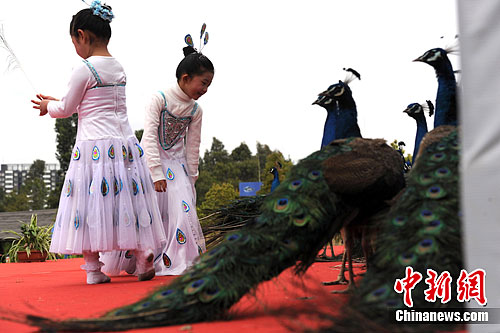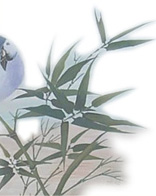|
|
|
 |
| |
|
|
|
[<<] [<] [>] [>>] |
| Title: Shirley's Art Works 720 & Stories Behind My Paintings 02 -- Chinese Xieyi 394-A93 - Shirley's 111st Assignment in Chinese National Academy of Arts --July 3, 2012 |
| Artist: Shirley Zhang |
| Size: 48cm x 200cm (18.89inches x 78.74inches) |
| Completed Time: July 3,2012 |
Remarks:
This is my 394th Chinese Xieyi Painting and my 720th painting since 2003, the 111st assignment in Chinese National Academy of Arts.
Peafowl ( 孔雀 kǒng què ) has another name -- 越鸟 ( Yue Niao ).
There are green peafowl, blue peafowl and white peafowl in China. The green peafowl is one of the national protected wild animals and it is precious as same as big panda.
The blue peafowl has been raised by human being generally in China.
There are still some wild peafowls living in Yunan Province.
Peafowl is one of the lucky birds in Chinese culture. There are many stories relate to it in Chinese history.
In Buddhism, Peafowl Was Born by Phoenix, It Was the Mount of Buddha and Bodhisattvas :
It is said, when the earth was first separated from the heaven, peafowl was born by the phoenix. At the first time, it was quite enormity so that it soaked people into its stomach from 40 or 50 miles far away, even Buddha was eaten by it. Buddha wanted to go out via its vent, but he worried about dirtying himself, therefore, he went out by dissecting the peafowl’s back. Buddha was angry with the peafowl and wanted to kill it, following the advices by the other Bodhisattvas -- To hurt a peafowl, is just like to hurt his mother. Therefore, Buddha brought the peafowl to the Ling Mountains and gave the peafowl a title: 佛母孔雀大明王菩萨-- The Mother of Buddha and Da Ming Wang Bodhisattva.
Peafowls then became the Mounts of Buddha and the other Bodhisattva, such Amitabha, the Buddha often rises on the peafowl, to help the human being.
Therefore, in Buddhism, peafowl symbolizes the Bodhisattva. In many Buddhism paintings, there are peafowls as the decorations or ornaments.
Another version said, peacock is associated with Kwan-yin. Kwan-yin represents qualities like compassion, watchfulness, love, compassion and goodwill. Legend says that Kwan-yin remained a mortal even though she could be immortal. She remained a mortal, to aid humanity in their spiritual growth.
Why Does a Peacock Display Its Tail Feathers?
When we think of a peafowl, the first thing we think, maybe how a peacock displays his tail feather.
In English, this situation is explained as Proud Peacock, or Proud as a Peacock.
In the actual life, a peacock displays its tail feather for two purposes:
-- To attract a peahen’s attention, it is an action of courtship display.
-- To defense the enemy. On the peacock's tail feathers, there are many colored gold lines, and many ellipse or circular "eye spots". They are made of purple, blue, brown, yellow and red color. In case the enemy is too late to escape, the peacock will suddenly open its tail feathers, and shakes the "rustling" sound, the eye-like spots are trembling at the same time, so that the enemy is afraid of this "multi-eyed monster", and not rush forward.
In Chinese culture, peafowl is auspicious symbol. People think that a peacock displays its tail feathers is a quite lucky thing, symbolizes the peace and luck.
In Traditional Chinese Medicine Field: Peafowl is an antidote for ( to) poison
In ancient China, earlier than the Song Dynasty ( 960-1279), there was the record that peafowl was used as medicine.
In the codex Xin Xiu Ben Cao , the first codex that was edited by the government had listed peafowl as medicine in it formally.
In the Ming Dynasty (1368 - 1644), Mr. Li Shizhen wrote in Ben Cao Gang Mu that Peafowl was an antidote for poison , can clean out the poison very well.
Application of the Peafowl Patterns & Feathers in Ancient China
-- In ancient China, the pattern of the peafowl meant 天下文明 (Tian Xia Wenming) -- Under the sun, it was a civilized world. So, it was used on the high rank grade officers’ uniforms.
In Ming Dynasty (1368 - 1644), the patterns of peafowl were used on the uniforms of the civilians who were on the third rank grade under the emperor.
In Qing Dynasty (1644 - 1911), the patterns of peafowl were used on the uniforms of the officers who were on the second and third rank grades under the emperor.
-- The pattern of 花翎( huālíng)-- the accessories that was made of peafowl's tail feathers on the offical hats of the officers in Qing Dynasty in the coral bottle, was called 翎顶辉煌 (líng dǐng huīhuáng) -- It would be brilliant on the hat with the tail feather, symbolizes the one who got the parttern would be promoted and have a good future on his offical caree.
Peafowl is also the symbolization of the rich and honor. In Chinese paintings, very often, peafowl and peonies appear together, the titles of this kind paintings, also includes the words 富贵(fù guì) -- riches and honour.
Usually, the feathers of the peafowl were used to make fans and the decorations in the imperial house.
In Qing Dynasty, they were used as the花翎 huālíng ? the hats’ ornaments of the official who had the official positions higher than the fifth grades, to distinguish the rank grades with the "eye spots" on the feathers.
There were the difference of the three eye -spots, double eye- spots and singles eye- spot. It is the symbolizations of the rank grade and power.
On the princes’ hats, were the tail feathers with three- eye -spots.
On the high officials’ hats, were the tail feathers with double-eye-spots.
On the general officials’ hats, were the tail feathers with one-eye-spot.
On the lower rank grade ( lower than 6th grade under the emperor) officers’ hats, instead of any eye spot of the tail feather of peacocks, what they wore were the pheasants’ tail feathers.
The symbolic meaning of Peafowl
-- In Chinese culture, peafowl was endowed nine virtues:
Peafowl’s feature is decorum; voice is clear; walk is easy and in the perfect order; does behavior according to the time and place; knows how to control itself on eating and drinking; often thinks of being in contentment; focus on the existing thing, is not excessive, and always knows returning.
Therefore, it is considered of the mascot and symbolizes the luck and many good meanings, Auspicious, kind, beautiful, gorgeous, lucky, peaceful, graceful , talent and so on, and be painted on buildings and other items to honor these much loved virtues.
In contemporary Yunnan ? the only place there are still wild peafowls there, people have a Peafowl Festival every year, I have attached a photo to show you about it and the logo of the Yunnan Television Station is just a peafowl.
Some Most Famous Chinese Art Works Relate to Peafowl
-- Poems:
Peafowl has been written in numerous poesies or poems by ancient poets in the Chinese poetry history, such as Si Ma Xiang Ru in Han Dynasty, Du Fu, Li Bai, Wang Jian, Han Yu, Li Shangyin in Tang Dynasty, Wen Tingyun in Song Dynasty wrote something about peafowl.
The first Long narrative poem in Chinese literature history in Han Dynasty (206 BC to 221 ) ? 孔雀东南飞 (Kong Que Dong Nan Fei ) ? Peacock Flying Southeast
The long narrative poem in Yunnan for more than 1000 years ?召树屯与楠穆诺娜 Zhao Shutun & Nan Mu Nuo Na召树屯与楠穆诺娜, now it has be adapted to be a movie.
-- Movie ? 孔雀公主 (Kongque Gongzhu)-- The Peacock Princess
-- Dance - 孔雀舞 ( Kongque Wu)-- Dance of the Peafowl

If you have any questions, comments or suggestions, welcome to write to shirley@ebridge.cn or shirleyz004@yahoo.com ,you can also publish your opinions on Message Board . :-)
--Shirley Zhang
July 9, 2012
|
|
|
|
|
|
| |
| |
|

